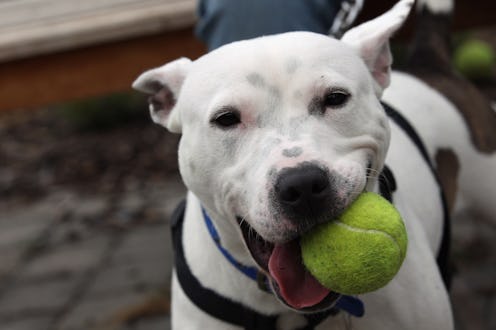Life
11 Rules Dogs Wish You'd Follow
I have basically no maternal instinct, but I am insanely broody about dogs. I love them all: huge, tiny, purebred, mutts, badly behaved, so well-trained they can do backflips on command. Most people at least have some preference — a size, say, or a tendency not to poo on your shoes. But my dude and I can deal with dogs of all kinds and stripes, because we grew up with some fairly special specimens. He had ex-racing greyhounds so neurotic they basically needed talking therapy; I had Akitas, huge Japanese beauties best described as "untrainable" and highly liable to sit on you and lick you for an hour. After that, all dogs are a piece of (furry, shedding, hilarious) cake.
Not a born-and-bred dog lover, but want to learn how to get close to them? Don't believe the hype about different breeds being more aggressive than others. Pit bulls, who have a seriously bad rap, can be some of the most gorgeous dogs around, while labradors, who are seen as the epitome of mild-mannered sweethearts, can have serious aggression problems. A huge amount of a dog's attitude to people is due to how it's been bred, trained, and treated by humans.
To help you out, here are 11 rules dogs would ask you to follow when it comes to touching and interpreting their body language, (translated into human by me).
1. Let me smell you first and keep yourself in sight.
Some dogs are nervous, others over-excited, but no matter how it greets you, giving it a good sniff of your hand is good manners. Don't move out of its sight area to give it a cuddle, either: dogs, with their huge expressive eyes, like to see what's happening with humans, whom they find fascinating.
2. Open mouths with tongues, grinning, and sniffing are good signs.
Reading dog expressions isn't all that difficult. A relaxed dog will have its mouth open in a grin with its tongue poking out, and if it's sniffing around you to see what you are, stay still — unless it goes for the crotch, which is pretty common. Just push its head lightly away.
3. Scratch behind my ears, my chest, and along the spine.
Dogs like both pats and scratches, but they've got particularly sensitive heads and backs. Don't touch their cheeks or neck unless you know them really well, but the upper chest area is a pretty good bet for a pat.
4. Keep away if I retreat, flatten my ears, or bare my teeth.
Dogs flatten their ears in two situations: when they absolutely adore somebody and are showing how much they love them, and when they're scared or angry. If you just met them, you are likely not the object of their adoration. Bared teeth are not smiles, either. And if they bark, definitely keep off.
5. A roll onto my back might be an invitation to pet, but be careful.
Dogs, unlike cats, like a good chest pat, but wait for the owner's invitation if that's what it's doing; it might just be scratching its back on the ground, and not be pleased when you dive in.
6. A paw on you means I want attention.
Dogs being cuddled are often pretty loath for it to stop. If you look over and discover a paw on your hand or leg, it's demanding attention. (My Akita used to head-butt stuff when she wanted people to pay attention to her.)
7. Roll up your hand into a fist and scratch gently inside my ears.
This is advanced-level cuddling, and must be done very gently — but many dogs do enjoy having their ears cuddled, and can't reach inside them to scratch easily because of their hind legs situation. Rolling a knuckle gently inside the ear opening might mean they lean their head towards you and assume an expression of pure bliss.
8. Don't touch my tail, nose, or paws.
Grabbing a dog's tail is no fun for them. If they offer you a paw, feel free to take and shake it, but otherwise they're not there to stroke or fiddle with; and the noses of dogs are very sensitive and need to be left alone.
9. A "bow" means I want to play.
If a dog "bows" — aka lowers its shoulders close to the ground while staring up at you — it's not about to start running. It wants to play with you, and the bow is a submissive gesture to let you know that everything that follows is meant to be fun.
11. Ask my owner's permission before you touch me.
Always, always ask before you touch anybody's dog. For one, it's polite, and for another, the dog might have likes or dislikes you really need to hear before you reach out a hand to touch the wrong part of its body.
11. Wagging tails aren't a guarantee that I'm happy.
Wagging tails can mean happiness — but they're a general communicator of a dog's strong emotion, and can also run the gamut from aggression to anxiety. If the dog is relaxed, has its tongue out, and the tail is high and wagging freely, you're on safe ground. If it looks tense, has its ears pointed forward, and the tail is low, keep off.
Images: GIphy.
